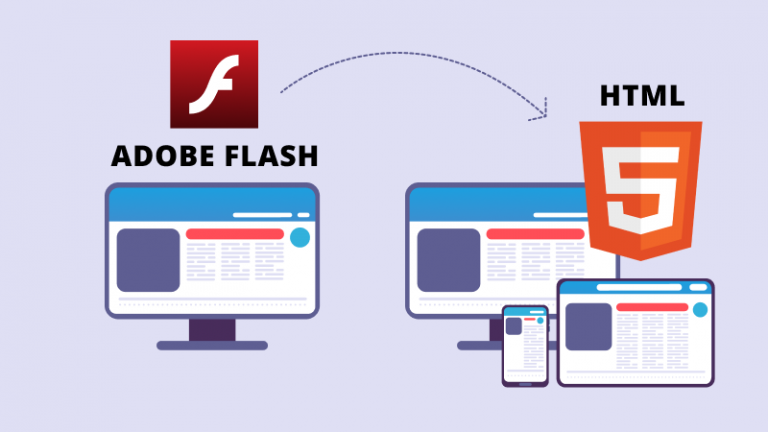Table of Contents
Adobe Flash Player support will end this year in December. The technology has become obsolete and have no place on the web anymore. Yet, as of this time there are more than 41 000 websites with embedded Adobe Flash Player functionality in US alone. What about them? There need to convert their content to HTML 5.
As soon as this info came, some of our clients started to inquire about converting the content of their websites to HTML 5 Canvas. Yes, we can do that.
What is Happening?
All major browsers Mozzila Firefox, Google Chrome, Edge, and Safari announced that they will switch off the default support of Flash Player by the end of 2020. The technology, although great in the past, has simply outlived itself. It was becoming harder and harder to maintain Adobe Flash Player as integrated in modern web functionality with JavaScript and HTML.
What are the Reasons?
Flash Player is not secure enough and it is also difficult to use and develop for on mobile phones and iPads. HTML 5 allows much faster and overall better functionality features.
Developers call security gaps loopholes. These are security flaws that can be used to corrupt, infect, and even take down a website or some part of its functionality.
Since Adobe Flash player have security loopholes that are difficult to avoid, integrating its components in modern web and mobile systems also come with a price.
Adobe Flash Player also drains smartphone battery very quickly. It is tough to built into different complex frameworks, especially on mobile. It has now been more than a year since smartphones stopped showing Adobe Flash Player elements in browser. In about a year desktop browsers will also stop supporting it for the benefit of universally applicable HTML 5 Canvas format that is overall much more efficient.
Universal Support
Adobe Flash Player cannot perform well on mobile devices (smartphones and tablets). This is called universal support and it is one of the main reasons it can no longer be supported in a cost-effective way. Internet users spend more time on their smartphones and less time at their desktops/laptops. Adobe Flash is not just not good enough for that.
It is essential for web components to play well on mobile devices just as they do on the desktop computers. Unfortunately, that cannot be done with Adobe Flash Player.
How to Convert Flash to HTML?
The following tools can be useful in your transition
- Adobe Edge
- Google Web Designer
- Adobe Captivate
- Animate CC
For example, Animate CC can be used to remake visual video elements and the insert them as part of content in HTML 5 format. Very simple elements like buttons can be done even without it and with a little less than almost no coding at all.
Strategy
There are certain steps you need to take before proceeding with conversion of your website content from Adobe Flash Player to HTML 5 Canvas. Most of the content (like 95%) can be accessed with HTML 5. However, the remaining 5%, especially that with rich interactive functionality (when users can inflict changes on the visible content like in games) should either be rewritten from scratch or abandoned altogether if it is not that important.
- Step 1 – Choose what content you need
- Step 2 – Find all possible original files (transcripts, videos, animations, images, and audio files)
- Step 3 – Choose Between Responsive Design and Adaptive Design
- Step 4 – Hire a Development Team
- Step 5 – Cobert Important Existing Content to HTML 5
- Step 5 – Pick Content Management Strategy to Add New Content
Legacy Content
You definitely need to choose what content needs to be converted. Some of the legacy content can be outdated and, therefore, there may not be a sufficient reason to convert it. Choose only that content that is crucial for your business purposes.
Most importantly, if the functionality of your website has been tightly connected with Adobe Flash Player (for example, interactive animations with buttons), you need to make sure that your users can continue actively engaging with content but based on HTML 5 functionality and not that of Adobe Flash Player.
In my research I found out that among the most popular Flash-dependent websites outside of gambling and games are educational platforms and online courses.
Coding
The troublesome part of Flash-to-HTML migration is legacy code. Adobe Flash Player was a pretty simple program that allowed doing a lot of things with practically no code. However, more complex features were added with ActionScript.
Unfortunately, ActionScript cannot be converted to JavaScript and what you need to do is to just code from scratch in JavaScript. However, the majority of Flash Player elements are done without code, so you can fully migrate them, using HTML 5 Canvas.

The Future
Adobe Flash Player had numerous faults when it came to mobile integration, video streaming, and security. Everything that was done with Adobe Flash Player before will be done using JavaScript and HTML 5 Canvas starting from now. Such a move will allow to shift towards a more optimal development in order to sustain universal accessibility to content on all platforms across different browsers and devices.
Experts claim that outside of web and mobile, Flash Player will perhaps be used by enthusiasts to create parts and blocks of game functionality in online casinos and simple games. Other major Adobe Flash Player domain – educational materials, will need to be converted into HTML 5 (if there is no extra rich functionality and much interaction) and new materials will appear disregarding Adobe Flash Player altogether.
Why Flash Was So Great
Flash Player was great because it allowed to create complex interactive video elements. For example, most online casinos operated (and they still do), using the functionality and tech stack of Adobe Flash Player. You don’t to be a game developer to do it, even some web-designers were able to handle this task.
A lot of user interactive functionality specifically important in, for example, online learning industry, was impossible to develop otherwise than using Adobe Flash Player. It was easy to do as well. Starting from HTML 5, the same features delivered by Action Script in Flash Player, will be done in HTML 5 and further integrated using JavaScript.
Conclusion
So, is it difficult to migrate from Adobe Flash Player to HTML 5? Not really, if your legacy content didn’t have much coding or a lot of interactive elements. Simple video tutorials or CTA buttons can be redesigned and integrated with HTML 5 and JavaScript.
Some heavier content will need to be rewritten from scratch, although it is only applicable to some 5% of content dependent on Adobe Flash Player. Even though making videos and other interactive web elements was very convenient with Adobe Flash Player, in a year or two developers will adjust completely to making the same things and even much more with HTML 5 canvas.
Nevertheless, this is a major improvement in terms of making all web components widely accessible across the different websites, browsers, and devices. You’ll be fine, believe me.






